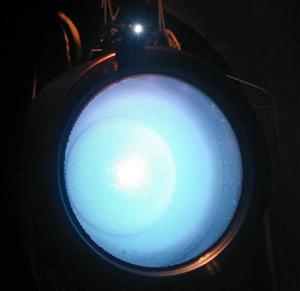Mon, Jul 01, 2013
Advanced Ion Engine Has Run Continuously for 48,000 Hours
A NASA advanced ion propulsion engine has successfully operated for more than 48,000 hours, or 5 and a half years, making it the longest test duration of any type of space propulsion system demonstration project ever. The thruster was developed under NASA's Evolutionary Xenon Thruster (NEXT) Project at NASA's Glenn Research Center in Cleveland. Glenn manufactured the test engine's core ionization chamber. Aerojet Rocketdyne of Sacramento, CA, designed and built the ion acceleration assembly.

The 7-kilowatt class thruster could be used in a wide range of science missions, including deep space missions identified in NASA's Planetary Science Decadal Survey. "The NEXT thruster operated for more than 48,000 hours," said Michael J. Patterson, principal investigator for NEXT at Glenn. "We will voluntarily terminate this test at the end of this month, with the thruster fully operational. Life and performance have exceeded the requirements for any anticipated science mission."
The NEXT engine is a type of solar electric propulsion in which thruster systems use the electricity generated by the spacecraft's solar panel to accelerate the xenon propellant to speeds of up to 90,000 mph. This provides a dramatic improvement in performance compared to conventional chemical rocket engines. During the endurance test performed in a high vacuum test chamber at Glenn, the engine consumed about 1,918 pounds of xenon propellant, providing an amount of total impulse that would take more than 22,000 pounds of conventional rocket propellant for comparable applications.
"Aerojet Rocketdyne fully supports NASA's vision to develop high power solar electric propulsion for future exploration," said Julie Van Kleeck, Aerojet Rocketdyne's vice president for space advanced programs. "NASA-developed next generation high power solar electric propulsion systems will enhance our nation's ability to perform future science and human exploration missions."
(NEXT ion thruster image provided by NASA.)
More News
Aero Linx: Model Aeronautical Association of Australia MAAA clubs are about fun flying, camaraderie and community. For over 75 years, the MAAA has been Australia’s largest fl>[...]
Touchdown Zone Lighting Two rows of transverse light bars located symmetrically about the runway centerline normally at 100 foot intervals. The basic system extends 3,000 feet alon>[...]
“Discovery and innovation are central to our mission at Virgin Galactic. We’re excited to build on our successful record of facilitating scientific experiments in subor>[...]
How To Get A Story On Aero-TV News/Feature Programming How do I submit a story idea or lead to Aero-TV? If you would like to submit a story idea or lead, please contact Jim Campbel>[...]
Student Pilot Reported That During Rotation, “All Of A Sudden The Back Of The Plane Kicked To The Right..." Analysis: The student pilot reported that during rotation, “>[...]
 ANN's Daily Aero-Linx (05.02.24)
ANN's Daily Aero-Linx (05.02.24) ANN's Daily Aero-Term (05.02.24): Touchdown Zone Lighting
ANN's Daily Aero-Term (05.02.24): Touchdown Zone Lighting Aero-News: Quote of the Day (05.02.24)
Aero-News: Quote of the Day (05.02.24) ANN FAQ: Contributing To Aero-TV
ANN FAQ: Contributing To Aero-TV NTSB Final Report: Cirrus Design Corp SR20
NTSB Final Report: Cirrus Design Corp SR20



